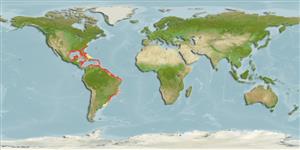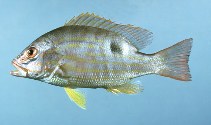مشاهدات خود را اضافه کنيد در Fish Watcher
| Native range | All suitable habitat | Point map | Year 2050 |

|
| This map was computer-generated and has not yet been reviewed. |
| Lutjanus synagris AquaMaps Data sources: GBIF OBIS |
Mexico country information
Common names:
Pargo biajaiba, Pargo viajaiba, Villajaiba
Occurrence: native
Salinity: brackish
Abundance: | Ref:
Importance: commercial | Ref: Anonymous, 1994
Aquaculture: | Ref:
Regulations: no regulations | Ref: Anonymous, 1994
Uses: no uses
Comments: Recorded from Laguna de Términos (Ref. 79080) and Celestún Biosphere Reserve, Yucatan (Ref. 74908). Year round fishing; marketed fresh (whole, fillet) or frozen (Ref. 26550).
National Checklist:
Country Information: https://www.cia.gov/library/publications/resources/the-world-factbook/geos/mx.html
National Fisheries Authority:
Occurrences: Occurrences Point map
Main Ref: Allen, G.R., 1985
National Database:
Occurrence: native
Salinity: brackish
Abundance: | Ref:
Importance: commercial | Ref: Anonymous, 1994
Aquaculture: | Ref:
Regulations: no regulations | Ref: Anonymous, 1994
Uses: no uses
Comments: Recorded from Laguna de Términos (Ref. 79080) and Celestún Biosphere Reserve, Yucatan (Ref. 74908). Year round fishing; marketed fresh (whole, fillet) or frozen (Ref. 26550).
National Checklist:
Country Information: https://www.cia.gov/library/publications/resources/the-world-factbook/geos/mx.html
National Fisheries Authority:
Occurrences: Occurrences Point map
Main Ref: Allen, G.R., 1985
National Database:
Common names from other countries
رده بندی / Names اسامي عام | مترادف | Catalog of Fishes(جنس, گونه ها) | ITIS | CoL | WoRMS | Cloffa
> Eupercaria/misc (Various families in series Eupercaria) > Lutjanidae (Snappers) > Lutjaninae
Etymology: Lutjanus: Malay, ikan lutjan, name of a fish.
More on author: Linnaeus.
Etymology: Lutjanus: Malay, ikan lutjan, name of a fish.
More on author: Linnaeus.
Environment: milieu / climate zone / depth range / distribution range بوم شناسي
دريايي وابسته به آب سنگ; تغييرات عمق 10 - 400 m (Ref. 9626), usually 21 - 70 m (Ref. 9626). Subtropical; 38°N - 38°S, 98°W - 31°W (Ref. 55253)
پراكنش كشورها | مناطق سازمان خوار و بار جهاني (FAO) | Ecosystems | ظهور | Point map | معرفي | Faunafri
Western Atlantic: Bermuda (Anderson, pers. comm.) and North Carolina, USA to southeastern Brazil, including Gulf of Mexico and Caribbean Sea (Ref. 9626). Most abundant around the Antilles, on the Campeche Bank, off Panama and the northern coast of South America. Lutjanus ambiguus (Poey, 1860), an intergeneric hybrid with Ocyurus chrysurus (Bloch) as demonstrated by Loftus (1992: Ref. 33006), followed by McEachran &. Fechhelm (2005: Ref. 78464).
Length at first maturity / Size / Weight / سن
Maturity: Lm 23.4, range 16 - 21.5 cm
Max length : 60.0 cm TL جنس نر / بدون خواص جنسي; (Ref. 40637); common length : 25.0 cm TL جنس نر / بدون خواص جنسي; (Ref. 55); بيشينه وزن گزارش شده: 3.5 kg (Ref. 40637); بيشينه سن گزارش شده: 10 سال ها (Ref. 3090)
Max length : 60.0 cm TL جنس نر / بدون خواص جنسي; (Ref. 40637); common length : 25.0 cm TL جنس نر / بدون خواص جنسي; (Ref. 55); بيشينه وزن گزارش شده: 3.5 kg (Ref. 40637); بيشينه سن گزارش شده: 10 سال ها (Ref. 3090)
توصيف مختصر كليدهاي شناسايي | ريخت شناسي | ريخت ستجي بوسيله انداره گيري
خارهاي باله پشتي (کل) : 10; شعاع نرم باله پشتي (کل) : 12 - 13; خارهاي باله مخرجي: 3; شعاع نرم باله مخرجي: 8 - 9. Preopercular notch and knob weak. Pectoral fins short, not reaching level of anus. Scale rows on back rising obliquely above lateral line. Back and upper side pink to reddish, with a green tinge and diffused darker vertical bars. The lower sides and belly silvery with a yellow tinge. A series of 8 - 10 horizontal yellow or golden stripes on sides. A diffused black spot mainly above the lateral line and below the anterior portion of the soft dorsal-fin rays.
Adults are found over all types of bottom, but mainly around coral reefs and on vegetated sandy areas. In turbid as well as clear water (Ref. 9710). They often form large aggregations, especially during the breeding season. Feed at night on small fishes, bottom-living crabs, shrimps, worms, gastropods and cephalopods. Good food fish, it is marketed fresh.
Life cycle and mating behavior بلوغ | تولید مثل | تخم ریزی | تخم ها | Fecundity | توزاد ( لارو)
Often form large aggregations, especially during the breeding season.
مآخذ اصلی
Upload your references | مراجع | هماهنگ كننده | همكاران
Allen, G.R., 1985. FAO Species Catalogue. Vol. 6. Snappers of the world. An annotated and illustrated catalogue of lutjanid species known to date. FAO Fish. Synop. 125(6):208 p. Rome: FAO. (Ref. 55)
وضعيت در فهرست قرمز IUCN (Ref. 130435: Version 2024-2)
نزديک به تهديد شدن (NT) ; Date assessed: 10 October 2015
استفاده انسانی
ماهي گيري – شيلات: تجاري; ماهي ها ي سرگرم كننده: بله; آكواريوم: آکواریوم عمومی
FAO(ماهي گيري – شيلات: production; publication : search) | FishSource | Sea Around Us
اطلاعات بيشتر
Population dynamics
Growth parameters
Max. ages / sizes
Length-weight rel.
Length-length rel.
نوسانات طولی
Mass conversion
بازسازی
فراواني
Growth parameters
Max. ages / sizes
Length-weight rel.
Length-length rel.
نوسانات طولی
Mass conversion
بازسازی
فراواني
Life cycle
تولید مثل
بلوغ
Fecundity
تخم ریزی
Spawning aggregations
تخم ها
نمو تخم
توزاد ( لارو)
پويايي لاروي
تولید مثل
بلوغ
Fecundity
تخم ریزی
Spawning aggregations
تخم ها
نمو تخم
توزاد ( لارو)
پويايي لاروي
Anatomy
منطقه آبششي
Brain
Otolith
منطقه آبششي
Brain
Otolith
Physiology
Body composition
Nutrients
Oxygen consumption
Swimming type
Swimming speed
Visual pigments
Fish sound
Diseases & Parasites
Toxicity (LC50s)
Body composition
Nutrients
Oxygen consumption
Swimming type
Swimming speed
Visual pigments
Fish sound
Diseases & Parasites
Toxicity (LC50s)
Genetics
ژنتيك
Heterozygosity
وارث
ژنتيك
Heterozygosity
وارث
ابزارها
E-book | راهنماي صحرايي | كليدهاي شناسايي | امكان نرم افزاري بسامد طولي | ابزار تاريخ زيستي | نقشه نقطه ای | Classification Tree
| Catch-MSY |
گزارش های ويژه
راجع به نگهداری آکواريم ملاحظه کنيد | برگه اطلاعات و مشخصات گونه ها را ملاحظه کنيد | برگه اطلاعات و مشخصات آبزی پروری را ببينيد
بارگيری XML
صفحه خلاصه | Point data | اسامي عام | تصاوير
منابع اينترنتي
Aquatic Commons | BHL | Cloffa | Websites from users | فيش واچر را ببينيد | CISTI | Catalog of Fishes(جنس, گونه ها) | DiscoverLife | ECOTOX | Faunafri | Fishtrace | GenBank(ژنوم, نوکلئوتيد) | GloBI | GOBASE | GoMexSI (interaction data) | | Google Books | Google Scholar | Google | IGFA World Record | MitoFish | پايگاه هاي داده ها | Otolith Atlas of Taiwan Fishes | آکواریوم عمومی | PubMed | Reef Life Survey | شناسايی RFE | Scirus | SeaLifeBase | Tree of Life | Wikipedia(برو, جستجو) | World Records Freshwater Fishing | Zoological Record
Estimates based on models
Preferred temperature (Ref. 115969): 19.7 - 27.5, mean 24.7 (based on 260 cells).
Phylogenetic diversity index (Ref. 82804): PD50 = 0.5000 [Uniqueness, from 0.5 = low to 2.0 = high].
Bayesian length-weight: a=0.01514 (0.01359 - 0.01685), b=2.96 (2.94 - 2.98), in cm Total Length, based on LWR estimates for this species (Ref. 93245).
Trophic level (Ref. 69278): 3.8 ±0.2 se; based on diet studies.
جهندگی (Ref. 120179): متوسط, كمينه زمان لازم براي دو برابر شدن جمعيت 4/1 – 4/4 سال (K=0.13-0.26; tm=2; tmax=10).
Prior r = 0.87, 95% CL = 0.57 - 1.30, Based on 6 data-limited stock assessments.
Fishing Vulnerability (Ref. 59153): Moderate vulnerability (37 of 100).
Climate Vulnerability (Ref. 125649): High to very high vulnerability (74 of 100).





